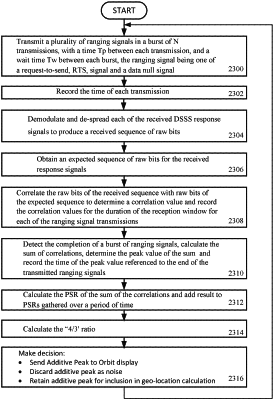| CPC H04W 4/029 (2018.02) [G01S 5/0221 (2013.01); G01S 5/14 (2013.01); H04B 7/18502 (2013.01); H04W 72/0466 (2013.01)] | 20 Claims |

|
1. A method in a first wireless device (WD) to discriminate between valid round trip time (RTT) measurements arising from reception of a signal from a second WD and false RTT measurements arising from noise, the method comprising:
transmitting a plurality of ranging signals to the second WD;
receiving from the second WD a plurality of ranging response signals responsive to the plurality of ranging signals; and
for each ranging response signal of the plurality of ranging response signals:
determining a sum of correlations, each correlation being between an expected bit sequence and a received bit sequence in the ranging response signal;
determining a standard deviation of the sum of correlations;
determining a first ratio of a peak value of the sum of correlations to the standard deviation to obtain a peak to standard deviation ratio (PSR); and
rejecting an RTT measurement corresponding to the peak value of the sum correlations when the PSR is less than a threshold.
|